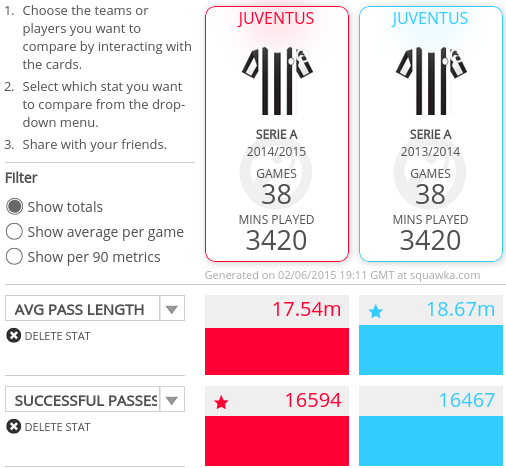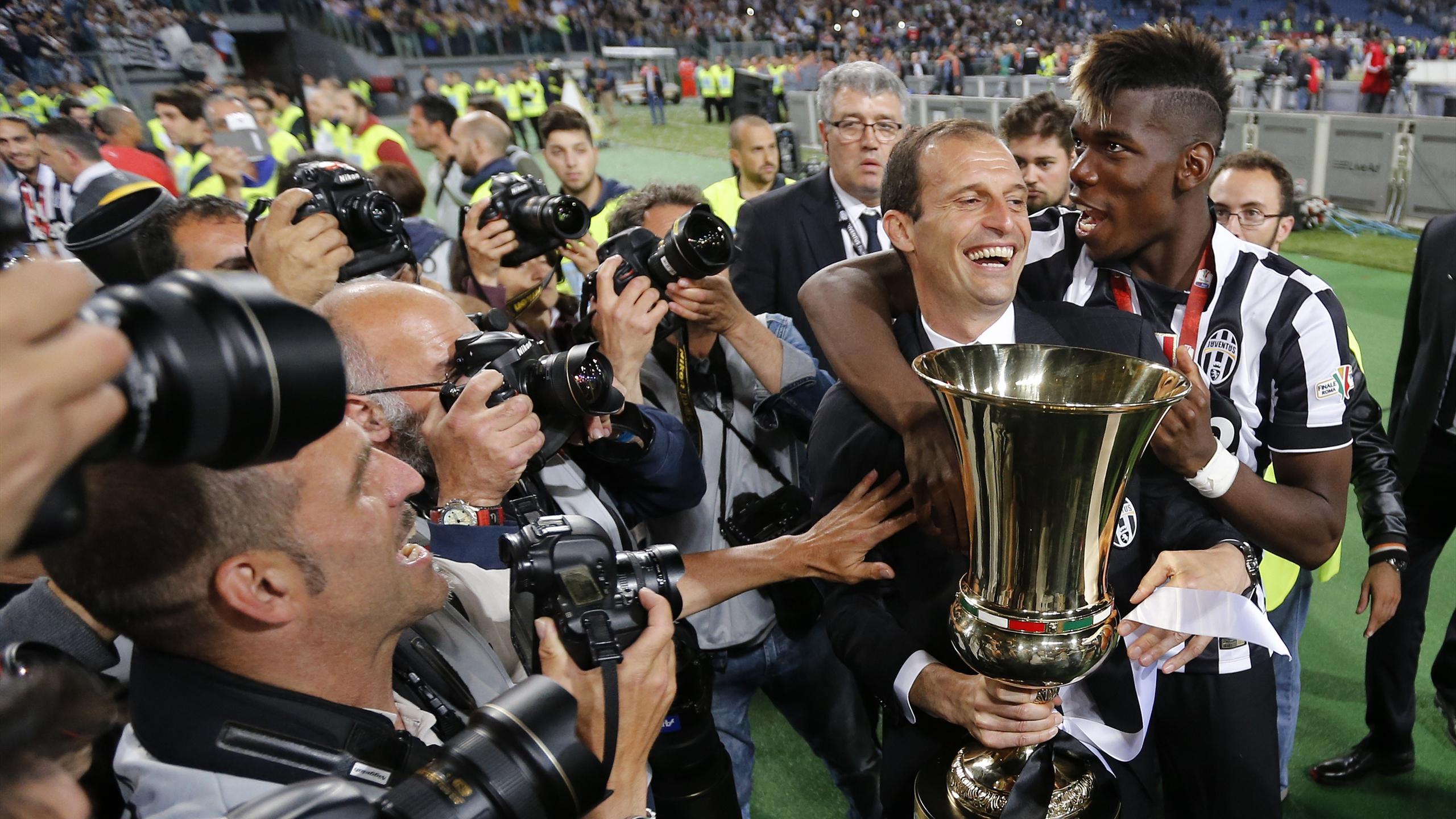How Massimo Allegri made Juventus a European superpower once more
/dnl.eurosport.com/sd/img/placeholder/eurosport_logo_1x1.png)
ByEurosport
Updated 04/06/2015 at 11:55 GMT
Greg Lea of Squawka.com looks at how Massimiliano Allegri has translated Juventus' domestic dominance into European glory.
How Massimo Allegri made Juventus a European superpower once more
Image credit: Eurosport
It was supposed to be business as usual. The date was Tuesday 15th July 2014 and Juventus’ planning for the upcoming season was well under way. Transfer targets had been identified and pre-season training planned as the club sought to win their fourth Scudetto in as many years. Everything was under control. Then the news broke.
Exactly seven days after the world of Brazilian football was left stunned by Germany’s 7-1 demolition of the World Cup hosts in the tournament’s semi-final, the Italian game was dealt a major shock of its own.
Antonio Conte, who had played over 400 times for Juventus and won three consecutive league titles as manager, had resigned, vacating the dugout in Turin to become the coach of the Italian national team. Just six weeks before Serie A was due to restart, the league’s leading light had lost its most vital component.
Andrea Agnelli, the club's president, moved quickly; Massimiliano Allegri was unveiled as Conte’s successor the following day. Derision abounded. According to most onlookers, this was to be the end of Juve’s dominance, a regressive appointment that would ensure the title would be heading elsewhere for the first time since 2011.
After all, Allegri had been sacked from his last job as Milan boss after overseeing their catastrophic decline into lower mid-table, the final straw coming with a 4-3 defeat to Sassuolo in January 2013 that left the Rossoneri floundering in 11th place, 30 points off top spot and just six above the bottom three.
Allegri’s appointment was thus widely considered a clear backwards step, a move that had handed the initiative to title rivals Roma and Napoli even before a ball had been kicked.
Fast forward 11 months and opinions could hardly be more different. Juventus have added another Serie A title to their extensive collection, finishing 17 points clear of runners-up Roma, as well as triumphing in the Coppa Italia for the first time in two decades.

Most impressively of all, the Bianconeri will contest Saturday’s Champions League final with Barcelona, aiming to secure an unprecedented treble and bring the famous trophy back to Italian shores after a five-year absence. The club’s supporters pelted Allegri with eggs on the day of his appointment; win his 38th game of the season this weekend, and he will go down in Juventus history.
The negative perception of Allegri on the peninsula was always somewhat unfair. His final campaign at the San Siro was undoubtedly a disappointment, but Milan’s troubles this term have shown that the club’s issues are deep-rooted and extend far beyond the manager.
Before that, the former midfielder won a Scudetto in 2010-11 and miraculously secured a Champions League place two years later, despite losing Zlatan Ibrahimovic, Thiago Silva, Alessandro Nesta, Clarence Seedorf, Gennaro Gattuso, Gianluca Zambrotta and Pippo Inzaghi in the summer window.
Allegri will exceed all of his previous accomplishments should Juventus win the Champions League this season. Despite their dominance in Serie A, Conte’s side struggled on the continent, comprehensively beaten by Bayern Munich in the quarter-finals two years ago before crashing out in the group stages last term. That has not been the case this time around, with Juventus doing superbly well to compete on two fronts.
Allegri has preached patience and control, instructing his side to pace themselves both in individual games and throughout the season. This is a different approach to Conte’s, who demanded permanent intensity and wanted his side to get the ball forward quickly, going for the opposition’s throat from minute one.
Juventus are still capable of fast and ferocious football, but they now also have another mode which helps them to conserve energy and bide their time.
This change has been reflected – albeit minimally – in two key statistics: Juve’s average possession has increased from 54 to 55%, and their average pass length shifted from 18.76 to 17.54 metres. Given that they have played almost 60 games this term, the more measured and sustainable style promoted by Allegri is sensible; with a treble still on the cards, it has patently paid dividends.

The second major alteration has been with their formation. Conte, a dogmatic coach who is unwavering in his devotion to a certain way of doing things, employed a 3-5-2 configuration in almost every single Juventus game he took charge of in his final two seasons at the helm.
The Bianconeri mastered the shape at home, but there was a feeling that it was holding them back when they faced better quality opponents abroad. Indeed, although all formations are neutral and it is their application that sets them apart, the 3-5-2 is generally vulnerable to the quick switches of play and overloads out wide that are more common in the higher-tempo games outside of Serie A.
Allegri is more of a pragmatist, willing to adapt depending on the opposition or circumstances he is faced with. Given the players’ prolonged success using it and his personal unpopularity at the time, it was logical for him to initially retain Conte’s favoured shape before gradually moving towards a back four as the season went on.
Claudio Marchisio neatly encapsulated the differences between the two managers in August. "Allegri has made us understand that we will not dwell on a single formation – we have a list of qualities that allows us to change identity during the game," the Italy international told Tuttosport.
"With Conte everything was more planned and the results speak for themselves – three League titles in a row and two Super Cups. Now it is different, Allegri has a different idea of the game.

"We work mainly on the possession of the ball. In Europe it works well, we saw it again last year when we faced teams with little to them – they played safe football, while we experienced some difficulties. Will this improved imagination be best felt in Europe? Definitely."
The first appearance of the now-familiar 4-3-1-2 came in November’s Champions League group stage tie with Olympiakos.
It seems strange to say today, but Allegri was under a fair bit of pressure heading into that game at the Juventus Stadium; the Old Lady were only three points ahead of Roma in Serie A, and had lost two of their three games in Europe, meaning that a loss at home to the Greek champions would condemn them to another premature exit.
Giorgio Chiellini and Leonardo Bonucci partnered one another in the centre of defence, with Kwadwo Asamoah and Stephan Lichtsteiner pushed back into conventional full-back roles. Andrea Pirlo played in his usual deep-lying position, with Paul Pogba and Marchisio acting as shuttlers slightly further forward.
Arturo Vidal was used at the tip of midfield, linking up with strikers Carlos Tevez and Alvaro Morata whenever possible.

After Pirlo netted to give Juventus the lead midway through the first-half, Olympiakos rallied to go 2-1 up just after the hour-mark. The 4-3-1-2 may have been immediately ditched had the score remained the same, but Juve scored twice in quick succession to secure a vital 3-2 win that set them on their way to the knock-out stages.
Since then, Allegri has switched between the two formations – sometimes even during games – resulting in a well-drilled and tactically flexible outfit. In both legs of the semi-final with Real Madrid, Juventus began with a 4-3-1-2 before switching to 3-5-2, as they looked to shut the game down and hold on to their advantage.
There is some debate over which of the two Allegri will use in Berlin. Many feel that a 3-5-2 would give Juventus the best chance of dealing with Barcelona’s incredible triumvirate of Neymar, Luis Suarez and Lionel Messi, while also matching up 3 v 3 with the Catalans in the middle of the park and retaining two strikers up top.
The more likely option though is the 4-3-1-2. This is partly down to personnel issues, with Andrea Barzagli doubtful at the time of writing; it is unlikely that Allegri would throw in Angelo Ogbonna, who has played only 77 minutes in this season’s Champions League, for such a big game. The four-at-the-back system is also more likely to prevent Tevez and Morata from becoming isolated, with the extra midfielder ensuring that Juventus are a greater threat going forward.
If the aforementioned Neymar-Suarez-Messi axis is undoubtedly the best attacking trio in the world, Juventus have one of the planet’s strongest defences; only Bayern Munich (18) and Barca (21) have conceded fewer goals than the Italian champions (24) in Europe’s top five leagues this season.
The evergreen Gianluigi Buffon has enjoyed another fantastic campaign between the sticks, while Bonucci has quelled long-standing doubts that he is unable to play in a flat back four.
The warrior-like Chiellini meanwhile has recovered from some shaky moments to return to his best form as the season reaches its conclusion.

Patrice Evra has had a terrific first year in Italy – particularly as other Premier League defensive imports such as Nemanja Vidic at Inter, Ashley Cole at Roma and Fiorentina’s Micah Richards have underwhelmed – and Lichtsteiner has excelled as both a full-back and wing-back.
Juventus’ defensive record is not just about the men who play deepest in the field though; defending, as they say, is a collective art and starts from the front, a mindset that no-one encapsulates better than Tevez.
Indeed, quite aside from his outstanding attacking contributions – Tevez has 27 goals and eight assists to his name in all competition this term – the former Manchester United and Manchester City striker has again demonstrated his incredible work-ethic and commitment to the cause.
Tevez’s pressing from the front and all-round attitude has had an infectious effect on his team-mates, who have seen the amount of work their best player is prepared to put in and followed his example.
Alongside the almost ever-present Argentine up-front, Morata and Fernando Llorente have rotated throughout the season. The former will get the nod on Saturday, his greater mobility and athleticism better-suited to a game in which Juventus will look to strike on the counter-attack.

The midfield is another area of strength, Pirlo, Pogba, Marchisio and Vidal complementing each other brilliantly. Marchisio, usually the least heralded of the quartet, has been the pick of the bunch this season, turning in some wonderful performances in a number of different roles.
Vidal has been getting back to his best in recent weeks after struggling with knee problems in 2014, while the number and identity of Pogba’s suitors speaks volumes about the Frenchman’s incredible natural talent. The 36-year-old Pirlo meanwhile remains as elegant and ethereal as ever.
It is difficult to argue that Barcelona do not deserve their status as heavy favourites heading into the Champions League final. After a relatively slow start to the season before Christmas, Luis Enrique’s side have been truly irresistible in 2015, winning 30 of 35 games, scoring 104 goals and conceding 23 on the way to wrapping up both the La Liga title and the Copa del Rey.
Nevertheless, it is worth remembering that most people did not envisage Juve even getting this far. Despite the upheaval they experienced in the summer, the Bianconeri have simply kept up their habit of winning football matches. At Berlin’s Olympiastadion on Saturday, they will be hoping for business as usual.
Greg Lea, Squawka.com
Scan me
Related Topics
Share this article
Advertisement
Advertisement